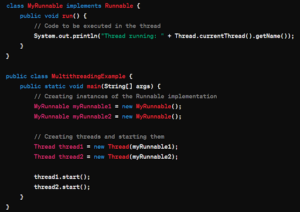To develop efficient, responsive, and scalable applications in Java programming, it is essential to have a profound understanding of the concept of concurrency. Concurrency enables the execution of multiple tasks simultaneously, which allows developers to utilize the complete potential of modern hardware and optimize the application’s overall performance.
This comprehensive guide provides a detailed exploration of Java concurrency, including multithreading, best practices, and practical insights that will enable you to master this critical aspect of Java development.
What Is Concurrency?
Concurrency refers to the ability of a system to execute multiple tasks simultaneously, allowing different parts of the system to make progress independently.
In the context of Java programming, concurrency enables developers to create mobile applications that can perform multiple tasks concurrently, improving performance, responsiveness, and scalability.
Concurrency in Java
Concurrency is a critical aspect of Java programming that allows multiple tasks to be executed simultaneously, allowing different parts of the program to make progress independently. This means developers can perform tasks concurrently, significantly improving overall system performance and responsiveness.
Java provides robust support for concurrency through its multithreading capabilities, which allow developers to create multiple threads of execution within a single program. These threads can run concurrently, enabling developers to perform complex tasks more efficiently.
Additionally, Java provides powerful synchronization mechanisms that allow developers to coordinate access to shared resources and ensure that concurrent tasks do not interfere with each other. By harnessing the power of concurrency, Java developers can build high-performance, responsive applications that can handle even the most demanding workloads.
Multithreading in Java
Multithreading is a crucial aspect of Java programming that allows developers to execute multiple threads of execution within the same program. Each thread represents an independent control flow, enabling different parts of the program to execute concurrently. Multithreading is used for carrying out tasks such as parallel processing, asynchronous I/O operations, and concurrent data processing.
To achieve multithreading in Java, developers can create instances of the Thread class or implement the Runnable interface. Threads can run concurrently, executing code blocks or methods independently within the same program. Java provides synchronization mechanisms such as locks, semaphores, and monitors to coordinate access to shared resources, preventing data races and thread interference.
Multithreading in Java has several advantages. It helps improve the overall performance of the program by utilizing available resources efficiently. It also enhances the responsiveness and interactivity of the program, making it more user-friendly. However, multithreading poses challenges such as race conditions, deadlocks, and thread starvation, which developers must address.
Below is a simple Java code example demonstrating multithreading using the Runnable interface. When you run this code, you’ll see both threads executing concurrently, each printing their names.

Java Concurrency
Java is a robust programming language that provides many features and APIs for managing concurrent execution in Java applications. Concurrency in Java refers to the ability of multiple threads to execute concurrently in a single Java application, which can improve the performance and scalability of the application.
One of the key features of Java concurrency is the Executor framework, which provides high-level concurrency utilities for managing thread pools and executing concurrent tasks asynchronously. The Executor framework simplifies managing threads in Java applications and helps ensure efficient use of system resources.
Java also provides synchronization primitives such as synchronized blocks and volatile variables to ensure thread safety and prevent data corruption in multithreaded environments. Synchronization in Java ensures that multiple threads do not access or modify shared resources simultaneously.
In addition to these basic features, Java concurrency also includes advanced features such as atomic variables, concurrent collections, and the java.util.concurrent package. These advanced features provide thread-safe implementations of common data structures and utilities for concurrent programming.
Atomic variables, for example, enable developers to perform atomic operations on variables, such as incrementing or decrementing their values, without the need for synchronization. Concurrent collections, on the other hand, provide high-performance, thread-safe implementations of commonly used data structures such as lists, maps, and queues.
Overall, Java concurrency is a powerful tool for developing robust, scalable, and high-performance concurrent applications in Java. By providing a wide range of features and APIs for managing concurrent execution, Java enables developers to write efficient and reliable code that can handle multiple threads and concurrent tasks with ease.
Effective Strategies for Managing Java Concurrency
To harness the power of concurrency in Java effectively, developers should adhere to best practices and guidelines for writing thread-safe and efficient code. Here are some tips for mastering Java concurrency:
- Understand Thread Safety: Familiarize yourself with the concepts of thread safety, synchronization, and race conditions to write robust and reliable concurrent code.
- Use Thread-Safe Data Structures: Prefer thread-safe collections and data structures from the java.util.concurrent package, such as ConcurrentHashMap and CopyOnWriteArrayList, to avoid synchronization issues and data corruption.
- Avoid Blocking Operations: Minimize the use of blocking operations and long-running tasks in critical sections of code to prevent thread contention and improve overall application responsiveness.
- Fine-Grained Locking: Use fine-grained locking and synchronization techniques to minimize lock contention and improve concurrency in multithreaded applications.
- Concurrency Testing: Thoroughly test your concurrent code using techniques such as stress testing, race condition detection, and concurrency testing frameworks to identify and eliminate potential concurrency bugs and performance issues.
Conclusion
In the world of Java programming, concurrency is considered one of the fundamental concepts that enable developers to create applications that are responsive, scalable, and high-performing. It refers to the ability of a system to execute multiple tasks simultaneously and efficiently.
By mastering the principles of concurrency, developers can take advantage of multithreading and leverage Java’s powerful concurrency features and APIs to build robust and efficient applications that meet the demands of modern software development.
To avoid conflicts when multiple threads access shared resources, developers need to synchronize and communicate effectively. Java’s concurrency utilities like Executor, Future, and Lock can help. Understanding concurrency enables developers to create applications that handle multiple operations simultaneously, delivering an optimal user experience.
